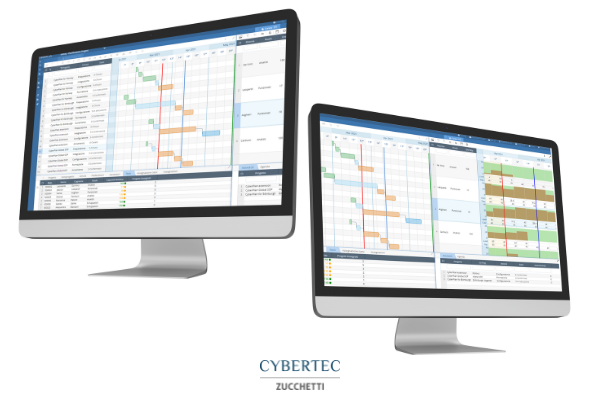Project Management allows you to manage projects more efficiently. The difference between theory and practice is often made by the use of Project Management software, which simplifies the management of a project in all its phases. Let’s find out why to use it and what features it should have.
Whatis Project Management
There is an increasingly important aspect for all those companies that aim to successfully face the global economic environment by developing a competitive advantage over their opponents.
This is Project Management, a set of activities that aim to manage all the phases of a project by analysing, designing, planning and carrying out its activities.
Linked to Project Management is the figure of Project Manager, who coordinates and controls the activities and people involved, supervising all aspects of a project and ensuring the achievement of objectives in compliance with the constraints of time, budget and resources.
The Project Manager is therefore not an easy task, because it requires many different skills to better manage resources and to organize projects. Fortunately, however, there are specific tools that help the Project Manager and their team to simplify this work.
Whatis Project Management Software
Project Management software is a tool for efficient project management. To understand their usefulness and potential, it is necessary to think about the fact that projects are usually complex and composed of phases, each with a series of actions to be carried out.
These software are useful in the initial stages because they allow you to plan and organize the work at the level of the resources to be used. They allow you to plan the timing of the project and allocate the budget according to the activities to be carried out. They are also useful for monitoring the results at two different times, both during the work and at the end of the project.
Given the growing importance of Project Management, today it is no longer just the big software houses that offer tools of this type, but the offer on the market has diversified and expanded to include options with different characteristics and prices. Orienting yourself among a large catalog can be difficult, so it can be useful to focus on the most important features that the software should have.
The features of Project Management software
When choosing a Project Management software, you cannot ignore the possibility that the software is collaborative. This allows the whole team to interact in the management of a project, stay updated on the progress of the activities and communicate in real time with all the people involved.
Since Project Management is based on resource management that respects constraints, another feature to look for in the solution is the possibility of managing resources strategically, organizing them into groups of activities, monitoring time and budget and always having deadlines and availability or other scheduled activities under control.
Another important aspect is that the interface is intuitive, so that through graphs, KPIs and indicators it is always possible to monitor the progress of the project.
Finally, the integration aspect should not be underestimated, choosing a solution that can be integrated in a streamlined way with other solutions and systems already in use in the company.

Why Use Project Management Software
Project Management software therefore helps managers and teams from different areas and sectors to manage a project in all its phases. Despite the fact that projects are managed every day in the most diverse companies, precisely by their nature they are united by the fact that they are always formed by the same phases that do not change. And it is during these phases that the software is useful.
In general, the first phase is that of start-up, in which the project is set up and started; then comes the design and planning where the requirements are identified; followed by the operational phase, which is more of an execution phase, during which the results that are monitored in the control phase are achieved, to ensure that they are aligned with those required; finally, in the completion phase the results are released.
The software makes it possible to plan and coordinate actions and tasks and facilitates the management of all these phases in a simple way, having data, timing and statistics of the results related to the project under control in a single management system. This minimizes effort and optimizes results.
Specifically, the risks of making mistakes, unnecessary costs and waste of time are reduced. They increase the satisfaction of the end customer and the motivation of the team that is satisfied to operate in an organized environment. In this way, the company grows teams that are increasingly able to respond to different customer demands in terms of complexity and develops more organisational capacity and greater forecasting capacity thanks to monitoring and control.
The risks of software for Project Management
As seen, companies that use Project Management software use it to plan, allocate resources, assign tasks, and track progress. Sometimes, however, these processes do not run smoothly, but they can have gaps that lead projects to fail. This is because some platforms do not track who is responsible for what, do not monitor the results achieved and in general do not offer a consistent approach to project planning and execution.
In addition to the software itself, other problems can arise from the way users approach the tool. In particular, the following emerge in these cases:
- Selection not made by the whole team but only by the manager, who may not understand all the features and tools that the work group will need.
- Rushed implementation, when it is a time-consuming process, especially when introducing a new tool that the team does not know and learning to use it takes time. That’s why it’s even more important to involve the team from the start.
- If the tool is too complicated and key functions such as assigning a task or creating a list are unintuitive, the process slows down.
- Too expensive due to numerous features and options that may not be used.
Project Management Software: Cloud vs On-Premise
Even in the field of Project Management software, many companies are wondering what is the best option between Cloud and On-Premise.
In the case of On-Premise, the software is installed locally on a company server or on a computer, and works on the basis of a license signed between the supplier and the user. Once purchased, there are usually no additional costs, but making the program accessible to many users requires the purchase of multiple licenses. It must be kept up to date to prevent security risks and threats, requiring additional work for those who deal with IT systems in the company. An advantage of an On-Premise software is greater privacy protection, since the data recorded by the software always remains in the possession and under the direct control of the user.
A Cloud software is installed on the provider’s server and is accessible remotely via the internet. As a result, an internet connection is always required to access a cloud service. Maintenance and installation of updates is the responsibility of the supplier company and the end user has less responsibility. But at the same time the data leaves the company servers and you have to give up full control over sensitive information. As for the cost, that of a Cloud software tends to be lower and usually works as if it were a subscription
Given these characteristics of the two options, each company can choose according to specific needs and objectives. Surely a Cloud solution allows you to enjoy scalability and new features.
The future of Project Management software
New technologies are changing industry and the economic fabric. The Project Management and services sector will also be impacted by the entry of new technologies such as artificial intelligence, the Internet of Things and advanced robotics. This will require project managers to develop new skills to manage the growing innovation. Similarly, it is likely that Project Management software will evolve to incorporate within it so as to be able to approach an increasingly complex, volatile and uncertain context.
The future of project management will depend a lot on:
- Continuous innovation to provide project leaders with the skills necessary for the new normal;
- Create an organizational culture based on greater communication and adapted to an increasingly collaborative work environment.
Project Management software integrations
Integration is a process that connects and puts different software in communication with each other. It is a useful practice especially for those companies that need to combine multiple databases to centralize data in a single system and be able to consult uniform metrics.
By its nature, Project Management requires visibility into a multitude of information, ranging from resource availability, specific skills, available budget and business objectives. This is why it is important to give access to this information, which is often contained in the management system.
In choosing the Project Management software, therefore, another parameter to consider is the ease of integration of the software with the other systems present in the company, in particular the management system.
CyberPlan RSP: software for Project Management
It takes little to improve project management and optimize your team’s work. CyberPlan RSP is powerful and intuitive project management software that helps teams work more productively, covering all aspects of project management simply and effectively.
Monitoring is facilitated by intuitive reporting systems to monitor the progress of activities and by constantly updated graphs to manage shared resources. Thanks to a simulated environment that allows you to analyze what-if scenarios, you can know in a few seconds the long-term impact of new projects.
Another advantage is the integration with the main management systems, such as Ad Hoc Infinity, Zucchetti HR and SAP or other APS software, which is smooth and fast in the exchange of data between the two systems. Data relating to projects and resources and their availability can be imported from the management system and confirmed project assignments and activities are exported.
CyberPlan RSP is ideal for Project Managers who want easy collaboration with their team and who need to make realistic dates based on resources and their availability. To find out more about its potential, browse the brochure on CyberPlan RSP in one click.
